No-Hook-Out (TM) Continuous Join Tutorial for Afghan Blocks of any size and yarn weight c. 2016 Margaret MacInnis
Materials: You need about 100 g (170 yds) of heavy worsted or aran-weight yarn for every 8-10 blocks of 12” each for joining; more for equalizing if you haven’t done that yet. If you are working with DK weight yarn, you will need less. I used exactly 200 g–7 oz for the cranberry join above in the photo; in fact, I had about 2 yds left, so 338 yds. Vanna’s Choice cranberry. My Canada Goose border is in Vanna’s Choice silver blue.
Hook: I like a US H or 5.0 mm for joining, one size smaller than I make most of my blocks in. DK users work accordingly.
Tapestry needle and Stitch markers: if you like to mark corners as you work
Time: 8-10 hours for 20-12” blocks, including a border round following
A)Equalize: to an odd number per side, plus a corner stitch or space. These blocks have 39 sts per side, and a corner space, but as long as they are all the same, and odd per side plus a corner st, you’re good.
B)Set up and decide on numbering system: I just take a photo and refer to it often, and then stack my blocks in reverse order; I actually flipped these piles upside-down, so I would take from them in the order needed.
 I had prepared these blocks with an equalize round, and then further put a border on them. They now have 39 stitches per side, with a corner sp. If you have oddly sized blocks, make them approximately the same size with some equalizing rounds, and perhaps a similar border. The border I used here is the Canada Goose Border that I also have a tutorial for.
I had prepared these blocks with an equalize round, and then further put a border on them. They now have 39 stitches per side, with a corner sp. If you have oddly sized blocks, make them approximately the same size with some equalizing rounds, and perhaps a similar border. The border I used here is the Canada Goose Border that I also have a tutorial for.
Equalizing any blocks: Decide on how many stitches the average block has already. If the blocks are all the same size, but differ in stitch count, you need to ‘equalize’ them to the same count. Sometimes, this can take two or more rounds, or you might be able to do it in one round. Your final goal for stitches for 9″ blocks for worsted-aran-weight yarn would be about 33 sts per side, with a corner st or sp additional to that–and after equalizing, they will be about 9.5 to 10″ square. For 12″ blocks, you might get 39 or 41 sts per side, with an additional corner st. That’s my count.
Working with swap blocks or blocks that differ in tension and size: Sometimes, you’ll receive a set of blocks in a swap or from someone else, and they all differ in tension and a few need a round or two to get them up to size–do that first, then, I just equalize them–working either a few judicious sc2tog or sc inc along the sides as needed. I bring them all up to the same st count, and use the same hook to do it.
For the purposes of this tutorial, spend the next little while equalizing or bordering your blocks that you have chosen to use.
JOIN INSTRUCTIONS
NOTE FOR THOSE WORKING BAMMM–you’ll have an additional round to what is shown here, but the instructions are the same. You’ll just have more ‘ch-2 spaces’ along the sides, too.
The first block gets 3 sides, starting and stopping with a sc in the corners as follows:
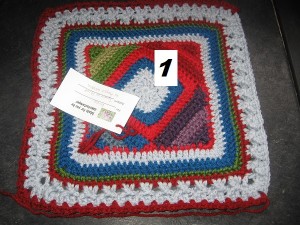 Block I: Join with a sc in any corner,*(ch2, sk st, sc in next st) to stitch before next corner, ch2, sk st next to corner, corner as (sc in corner st or sp, ch3, sc in corner st or sp), repeat from * to fourth corner, sc in fourth corner only.
Block I: Join with a sc in any corner,*(ch2, sk st, sc in next st) to stitch before next corner, ch2, sk st next to corner, corner as (sc in corner st or sp, ch3, sc in corner st or sp), repeat from * to fourth corner, sc in fourth corner only.
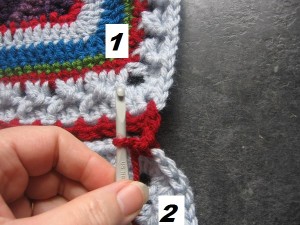 Block 2: Line up Block 2 below Block I. Now you’ll work from Block 2, back into the Block 1 ch-2 sps you just made. First, work a
Block 2: Line up Block 2 below Block I. Now you’ll work from Block 2, back into the Block 1 ch-2 sps you just made. First, work a
CORNER ONE: From sc in Block 1 corner, ch2. Sc in Block 2 corner, ch1.
Join sequence: from Block 2 to Block 1. *From ch1, join in first ch-2 sp on Block 1 with a sl st. Keep yarn to your left and below.
Ch1 from sl st.
Skipping next st in Block 2, sc in next st. Ch1 again, sl st in next ch-2 sp on Block 1*. Repeat until you get to the next corner.

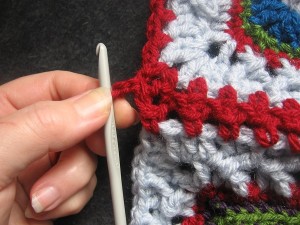
 CORNER TWO: From ch1 after the Block 1 sl st, sc in Block 2 corner sp or st. Ch 1. Sl st in Block 1 corner ch-3 sp that you made before. Ch2, sc in Block 2 same corner st or sp as first sc was made.
CORNER TWO: From ch1 after the Block 1 sl st, sc in Block 2 corner sp or st. Ch 1. Sl st in Block 1 corner ch-3 sp that you made before. Ch2, sc in Block 2 same corner st or sp as first sc was made.
CORNER TWO complete.
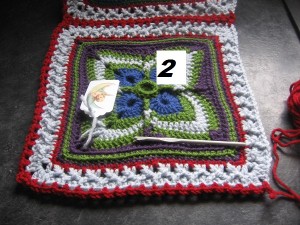 Continue around the Block 2 you just joined, the same way you edged Block 1 before you began, with sides as (ch2, sk st, sc in next) and corners as (sc, ch3, sc) in same sp or st, except the fourth corner just gets a sc, ch2—preparatory to joining new Block below it.
Continue around the Block 2 you just joined, the same way you edged Block 1 before you began, with sides as (ch2, sk st, sc in next) and corners as (sc, ch3, sc) in same sp or st, except the fourth corner just gets a sc, ch2—preparatory to joining new Block below it.
Joining Rest of Column: Now, you’ll treat each of the rest of the blocks in the first Column the same way, except for the last one (which doesn’t get three sides, only 2). Work Block 3 to Block 2, and Block 4 to Block 3. This photo shows Block 4 (CORNER ONE being made) being joined to Block 3. The others are fan-folded above.
The last Block in a Column: is treated a little differently, since you’ll be starting the new Column to the left of it—sc in third corner, and ch2. You’ll be making a new CORNER ONE—see above, just as you did when you joined Block 1 to Block 2.
FLAPPING IN: New Column: first, work a CORNER ONE, then join the side the same as before, going right from CORNER ONE into the first ch-2 sp in the block above it. You’ll find it easier to turn your work, but the photos show it as it is, in order to show you where we are. Keep a mental note of ‘bottom of Column Two, Flapping In’, as you work the four (or however many) blocks into the new Column. As you finish joining the first sides, you’ll reach the CORNER THREE, which is at the end of the arrow.
CORNER THREE is the most difficult. You are going from block top right, to block bottom right below, to junction, to new block bottom left, to block top left.
“you are working a W from block top right, to block bottom right below, to junction making a slip st around the (original slst joining chain 3s), to new block bottom left, to block top left.”
From sc in last ch-2 sp of Block 4, ch1, sc in corner st or sp of Block 5, ch1.
Insert hook into the target hole (see yellow circle) which is the junction of CORNER TWO. You work it around the SLST there, not into any ch-3 or anything like that.
Sl st, and ch1
This is the tricky part! Directly from that junction sl st and ch1, you go to the corner of the NEW BLOCK.
sc in that corner, and ch1 as always.
Then you will be joining the two sides of the new block with the old column block above it. Flapping In, I call it, since the blocks are flapping, and not joined between them yet.
Work the join between the Columns as normal, going directly from the sc/ch1 in the corner, to the first ch-2 sp above left, then sk st on below block, and sc in next one… For now, you just have one sc in each of the two new block corners, but that will be fixed later, when we come back around and join those blocks. Just ignore that, and keep working the Flapping In.
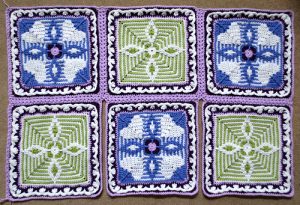 Photo dakotastamper of flapping in.
Photo dakotastamper of flapping in.
This is a photo of Column 2 joined to Column 1, Flapped In only. I’m just working the last few blocks on, making CORNER THREE’s as I work.
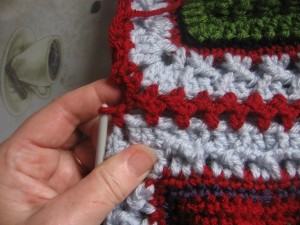 At the last block in the column, make a CORNER TWO.
At the last block in the column, make a CORNER TWO.
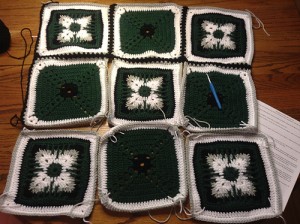 This is also where people get the most confused. Wg96girl sent me this photo from Ravelry, and wondered how to proceed. We advised her to take away those next three blocks, and FINISH THE FLAP JOIN FIRST. You have to finish the Flap Join on the current column, before you can join a new column to it. Follow below.
This is also where people get the most confused. Wg96girl sent me this photo from Ravelry, and wondered how to proceed. We advised her to take away those next three blocks, and FINISH THE FLAP JOIN FIRST. You have to finish the Flap Join on the current column, before you can join a new column to it. Follow below.
The next step will achieve what I call Flap Join. You will work around the whole edge of the top block of that Flapped In column, until you get back to where the CORNER THREE is, and you’ll be turning it into a CORNER FOUR.
a)sc into the corner sp or st of the block you are working on (there is already a sc in there), ch1
b)locate the junction sp you will be slipping into
c)sl st into junction, and ch1
Then immediately think, ‘oh, are there any corners not finished, that don’t have 2 sc in them?’ YES. The one on the block below your hand, that’s going to be joined as a Flap Join.
d)So sc in that corner.
Now it’s all making sense? The rest is just repeating what you’ve just learned. Work the Flap Join on those two adjoining edges as always. Work a CORNER TWO when you get there. Come around the next block, back to where the CORNER THREE is, to change it into a CORNER FOUR. Repeat until all the blocks of the second column are Flapped Joined.
Then repeat the New Column addition to the left of the Old Column, just like you joined Column 2 to Column 1, first Flapping In with CORNER THREES, then Flap Join with CORNER FOURS.
Flap Join continues.
At the very end of all the column flap joins, you’ll only be left with bordering the very outside edge to meet up with the first sc you made at the beginning.
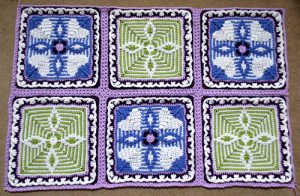 Flap joined and ready for new column/row
Flap joined and ready for new column/row
Continue around the edge, working sc in every second st, ch2 between them, corners as (sc, ch3, sc) in corner st or sp, and work CORNER FIVE–which isn’t really a CORNER, but more a junction management.
CORNER FIVE: at the junctions of blocks as ‘sc in first block corner st or sp, ch2, sl st in junction sp, ch2, sc in second block corner st or sp), then continue along the side of the block, with (ch2, sk st, sc in next st).
Continue around, working all the block junctions as CORNER FIVE, and working the sides of the blocks as (ch2, sk st, sc in next st) with outside corners as (sc in corner sp or st, ch3, sc in same sp or st). Finish by sc in final corner, ch3, join with sl st in beg sc–the very first one you made on the very first block. Weave in ends, and admire. Next we’ll work up a border for this same afghan, that will ‘fix’ those dips in the junctions.
EDGING
With Edge Color — I use the same cranberry, you can work a sc, or hdc, or dc edge as follows:
Edge 1: sc: Join Color used for last round or continue in same corner, ch1 or join with sc. If making sc round, work 2 sc in each ch-2 sp, and work 2 hdc in each ch-2 sp on either side of the junctions between the blocks, cornering as 3 sc in ch-3 corner sp.
hdc: If making hdc round, work similarly, but work 2 dc in each ch-2 sp on either side of the junctions.
dc: If making dc round, work similarly but start with a ch3 as dc, and work 5 dc in each corner ch-3 sp, working 2 trc on each side of the junctions.
BORDERING
Any of these edgings can now be used as a base for a border. I’ll post a couple of border ideas tomorrow.
Meanwhile, back at the farm:



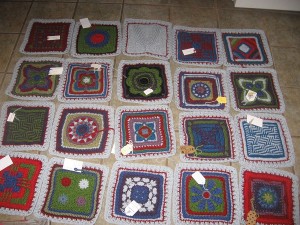


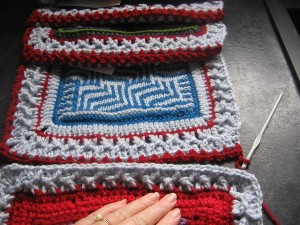
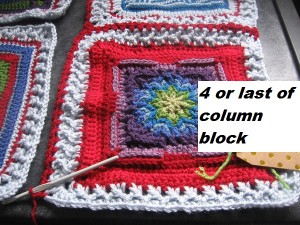

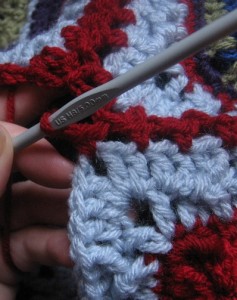

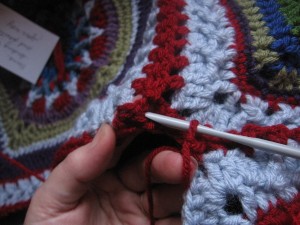


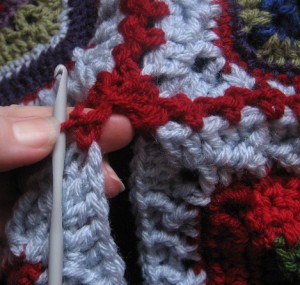
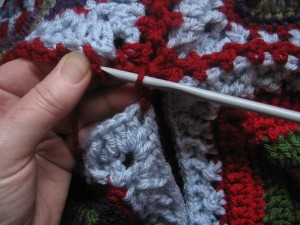
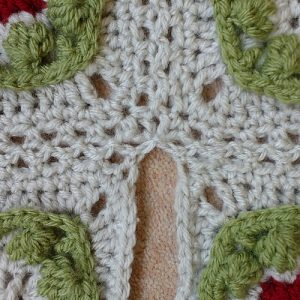

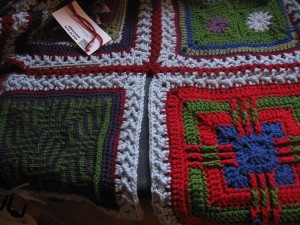
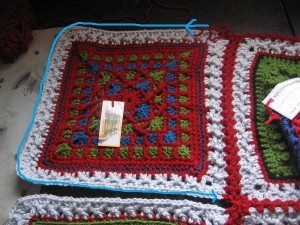


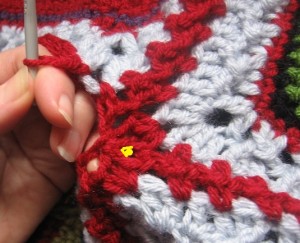
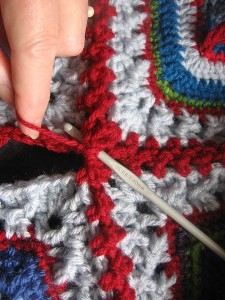

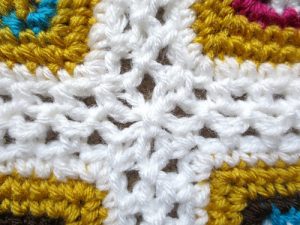
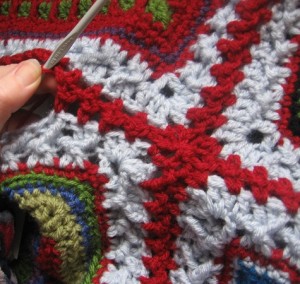
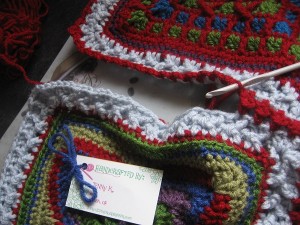
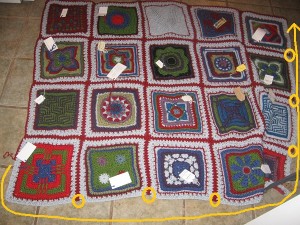
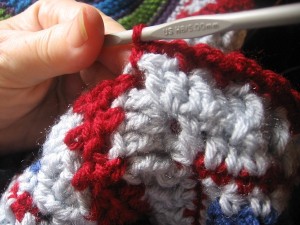
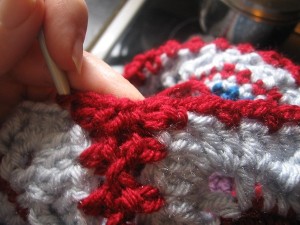


Pingback: Bordering the No-Hook-Out afghans | Designs By Muggins
Pingback: No-Hook-Out Continuous Continues…. | Designs By Muggins
Wonderful tutorial. Very thorough. Excellent end result!
Thank you! I really enjoyed designing it to make it readable and workable for everyone! M
Oh thank you for this! I had worked out a way to join without taking the hook out It is the same as yours) but was stumped by the corners and couldn’t find anything that would help. So yay I can now do my 2015 Bam Afghan, so thanks again you clever lady.